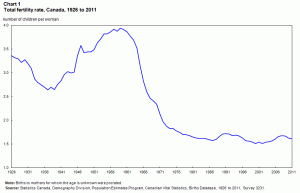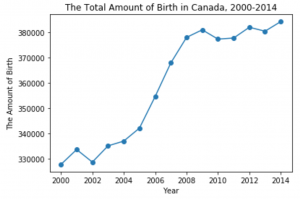Over the past decades, Canada has been converting from a high-fertility society to a low-fertility society continuously. While the number of kids in a family keeps decreasing, the moms are getting more and more aged.

The fertility rate in Canada has remarkably decreased over decades.
Source: Statistics Canada
Well, how much impact does this reduction have on the population in Canada? Let’s take a look at the data of live births in Canada over a recent dozen years.
With the development of Canadian society, birth rate, birth weight and their relations to genders are affected by a variety of factors, such as lifestyles, environment, financial conditions and some biological reasons.
The dataset ‘Live births, by birth weight and sex, Canada, provinces and territories’ contains number and percentage of live births sorted by birth weight, sex and areas in Canada through 2000 to 2014, accessible via Open Government Portal, Government of Canada.

Source: https://www.parents.com/baby/care/newborn/new-mom-first-6-weeks/
According to a scatterplot of the overall trend of birth rate in Canada, 2000-2014, there is a consistent increase during the period of 2002 to 2008, and the number of birth increases rapidly from 2005 to 2009. Even though there are some fluctuations in these years, the overall trend is going up.

The amount of birth in Canada has soared over the 14 years.
From the further analyses conducted with the dataset, a more detailed idea of birth amount and birth weight in Canada in recent decade has arose. From 2000 to 2014, the overall amount of live births obviously increased by 4746.92 per year, but it fluctuated between 2000 to 2004 and 2008 to 2014. The period when the birth rate rapidly increased is from 2004 to 2007.
Fortunately, according to the above analysis, the number of live births in Canada over the period 2004 – 2007 was not influenced as badly as it looks at the first place. Even though factors that could negatively affect the population in Canada would always go with the development of the country, it can still be seen that the amount of newborn babies remains quite satisfactory from year to year.
Siqi Tao
